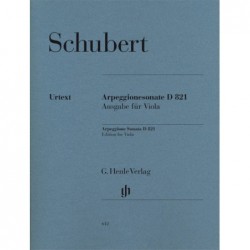Sonata For Piano And Arpeggione In A Minor D 821 - Franz Schubert
Good intentions are simply not good enough (to freely paraphrase Kurt Tucholsky): the arpeggione, a kind of hybrid instrument like a large bowed guitar, never won acceptance among musicians. This curiosity of instrumental engineering would certainly have long since been consigned to oblivion had not Franz Schubert of all people composed his A minor sonata for it. This three-movement work is now truly immortal, but at the same time presents a problem as an Urtext because the original arpeggione part cannot be performed on those instruments that most closely approximate its sound clearly the viola or violoncello without some interventions in the text. G. HenleVerlag solves the dilemma on the one hand by setting the arpeggione Urtext part above the original piano part (score), and on the other by clearly denoting the few necessary octave shifts in the included instrumental parts. Out of the question for the publisher was a transcription for another instrument such as the violin (as was included in Diabelli's posthumous first edition), flute, or other high melodic instrument, because these are simply too far removed from the sound Schubert had in mind. At best, a contrabass part might still work. Or ??
Pag: 56







